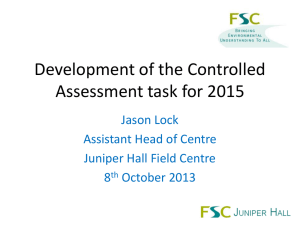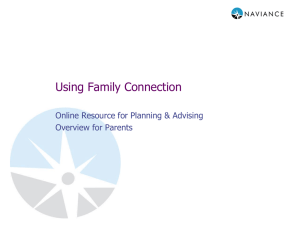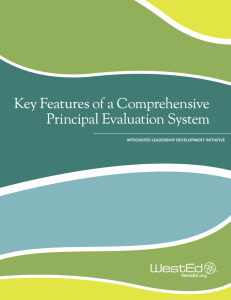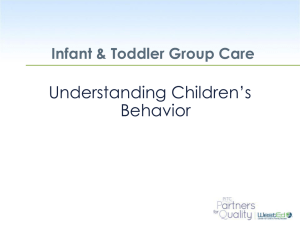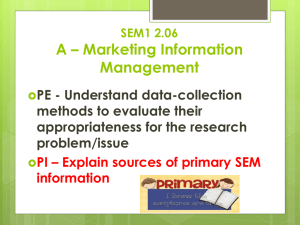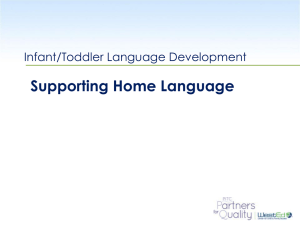Using a Parent Survey to Improve Parent Involvement & School
advertisement
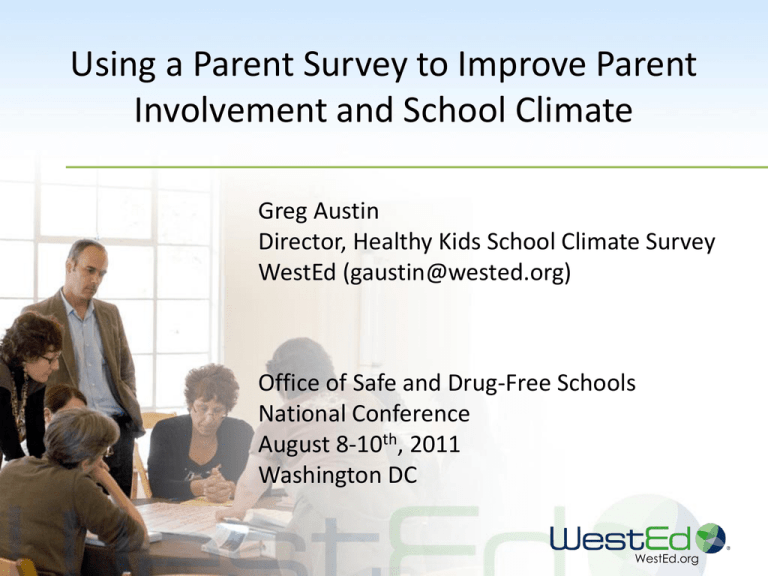
Using a Parent Survey to Improve Parent Involvement and School Climate Greg Austin Director, Healthy Kids School Climate Survey WestEd (gaustin@wested.org) Office of Safe and Drug-Free Schools National Conference August 8-10th, 2011 Washington DC WestEd.org Presentation • Importance of assessing parents on school climate and experiences with school • The Healthy Kids School Climate Survey (HKSCS) • Assessment challenges • Strategies for improving survey participation What Promotes Parent Involvement • Communicating and demonstrating that parents are valued by and welcomed at school. • Three “developmental” factors • Positive staff-parent relationships — caring, trust, support • Opportunities for meaningful participation — decisions making, contributory activities • High expectations 3 Value of Parent School Climate Surveys • Data to guide school improvement and parent involvement efforts - Need views of whole school community - Compare student, staff, parent results to identify commonalities and disconnections to address 4 Value of Parent School Climate Surveys (2) • Can and should enhance parent involvement - Asking for information conveys interest — that you value their input; you care. - Sharing results keeps parents informed about their children and school — a key involvement strategy. - Even more important: involving parents in addressing identified needs (decision-making) • An exercise in meaningful participation 5 Healthy Kids School Climate Surveys • Three comparable instruments: – Student, elementary (grade 5), middle, high school (since 1999) – Staff, K-12 (since 2004) – Parent, K-12 (since 2010) • Customize with added questions – Not just surveys but a data collection system • Online and paper versions – Students/staff separate scannable answer sheets – Parent scannable (OMR) booklet • Developed under funding from the California Dept of Ed, 1997present The HKSCS In California • Comprises the California School Climate Health and Learning Survey System (Cal-SCHLS). – Includes California Healthy Kids Survey for students • The largest effort in the nation to provide schools/communities statewide with local data from students, staff, and parents to: – Identify and meet the needs of students and promote academic achievement, positive development, and well-being. – Improve school climates, teacher satisfaction and retention, and parent involvement • Identified as a model by ED (Successful, Safe, & Healthy Students) • For further information: www.cal-schls.wested.org Survey Supports and Resources • Detailed administration guidebooks, webinars, and instructions • Phone consultation • Data processing and reporting - School, district, county, and state • Survey Content Guidebooks • Data Use Guidebook • Data Workbook to Improve School Climate and Close the Achievement Gap 9 Other Major HKSCS Users • Building Capacity in Military-Connected Schools Consortium (student, staff, parent) – 148 schools (K-12) in southern California annually, 2011-2015 – Developed special modules to better assess needs of schools serving students in families in the military. • Safe and Supportive Schools grants (student, staff, parent) – California, 300 schools in 60 districts – Louisiana, 86 schools in 8 districts – West Virginia, 48 schools • National Evaluation of Safe Schools/Healthy Students grantees (staff only) • School Turn-around Center, WestEd (staff, parent) HKSCS Parent Survey • Newest survey, just beginning • Shortest (34 questions) • Voluntary and anonymous • Online and/or paper – Same online instructions as with staff survey – Paper Optical Mark Recognition booklet – Survey staff combine data into one file if both used • Translated into 26 languages – Reach 99% of parents and caregivers in California – Online and OMR instruments now only English and Spanish • California School Parent Survey information: www.cscs.wested.org Development Goals • Keep it simple — low burden on schools • Keep it short — not time consuming for parents • Make it meaningful – School outreach to and involvement of parents – School environment and student/parent supports • Comparability with student and staff survey data • Information parents would want to give and likely to know Content • School welcoming/informative to parents • Parental involvement in education of children • Students cared for and treated fairly, respectfully • Equity of opportunities • Students held in high expectations • Problems at school from student behavior (AOD use, violence, bullying, truancy, etc.) • Clarity and equity of discipline • Perceived school safety Parent Survey Reliability 2010-11 Administration • Parent respondents – 2,000 in elementary schools – 1,300 in middle schools – 12,000 in high school schools (largely S3) • Online vs. paper – Military-connected schools, split evenly – S3 in California 73% paper, 27% online – West Virginia and Louisiana S3 option only online Some California Results • Parent involvement and almost all indicators of a positive school climate decline after elementary school – Especially perceptions promotes academic success, inviting place to learn, safe place, treat students with respect, enforce rules equitably, encourage classroom and meaningful participation. • In high school: – Only about 20% strongly agree school welcomes parent involvement, promptly responds to parent calls, encourages involvement – Only about 30% well-informed of school activities and child’s progress • Concerns over student behaviors posing a problem at school dramatically increase after ES, with exception of physical fighting – Biggest change for AOD use (highest in HS, among lowest in ES) Strategies for Improving Parent Participation Encouraging Participation Essential • High participation is needed to ensure data is representative and of value for program decision making. - Higher the better to have confidence in data value - Minimum 60% response rate • Lower response rate doesn’t mean the data not valuable — but representativeness uncertain 18 Typical Parent Response (Participation) Rates • Paper: Average district-sponsored surveys 30% – New York City: 45% — with heavy PR investment – Wide variation across districts and schools • Online: Negligible – LAUSD, when given option <1% • High school rates lower – California S3 (mixed paper/online): Only 6 out of 46 districts over 30%; majority under 10% • Needier schools lower – 25% of parents in LAUSD inner-city high school reported no Internet access or working computer. Los Angeles Parent Survey • Mail-out paper survey with return mail envelop, with high public relations effort. – 28% RR overall; 16% high school. • Now having schools send out themselves via students – School monitoring – Some giving incentives (e.g., raffle ticket for returning) • Same technique effective for parental consent return Planning and Development • Start early to obtain support and raise awareness • Develop/select survey that is simple, brief, with patently relevant content to parents • Promote sense of ownership among parents and staff from beginning – Get wide input into content/selection and administration process • Plan along with student and staff surveys – Coordinate content to reflect whole school community – generate enthusiasm throughout school community • Develop both online and paper versions – Assume most paper but some will like online convenience Obtain Administration Support • First step: Obtain superintendent and principal(s) support – Wide variation in response rates occur across and within districts • Meet early and get input • Review survey content, purpose, value • Review plans for raising staff/parent awareness and ensuring high participation rates – Emphasize importance that they communicate participation expectations to staff and parents • Establish protocol and timeline for updating Raise Parent Awareness • Advance notification • Send informational packets to teachers and parents • Publicize using many venues – – – – – Newsletters sent home Staff meetings Parent meetings (PTA) Signs at school School events • Have ALL staff support and encourage participation Encourage Participation: What to Stress • Survey convenience, simplicity, and brevity • Value and need of data for school community – Identifying and addressing the needs of students and school conditions that are barriers to learning and overall well-being – Improving: • Parent involvement and supports • Student attendance, academic performance, and graduation. • Student services and supports • Teaching conditions • The opportunity for parents to communicate confidentially and anonymously their perceptions of school – Allay concerns What to Stress • Positive goals – Surveying not to point blame but help; to identify problems to address, supports that are needed, and strengths on which to build. • Desire to hear parent voice and intent to act on it. – Convey confidence that you will be using their input — It’s worth their while to do the surveys. – Describe plans for using data. Dissemination and Return • Make convenient to fill out and return • Mailing surveys with return envelops doesn’t necessarily improve participation – LAUSD 28% RR (16% high school). • Send home with students – Send with student survey parental consent forms so they can see connections. • Hand out when parents register students • Provide time to take during parent meetings (Back-to-School, PTA) • Have copies and drop-off return box in school office • Provide incentive for return (e.g., each student gets a raffle ticket for school supplies) Monitoring • Follow-up to encourage completion: mail, newsletters, notes home, signs at school. • Online: Monitor real-time response rates and increase outreach if needed. Data Use • Involve parents in reviewing results and action planning. – Not just parent but student and staff results – Decision making on what to do to address needs – Inform of actions taken to meet identified needs and program outcomes – Demonstrate their input has made a difference • Outcomes: – Improved parent involvement and survey participation – Improved school climate, student performance and well-being





